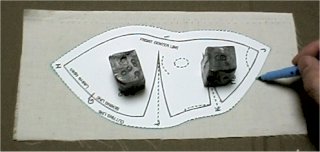
Abstemious little Cindy in the scullery
Optional Pattern and Instructions
Back to entrance page

To my joy, as soon as I opened Cindy's page, I received many emails. Thank you for your email. Most of them were written about Cindy's cloth made head. Reading them, I thought it is hard to get the plastic head. And many people want to make a fully cloth made doll. So I try to write instructions about it.One of my friend said "A doll without hands, feet and fingers looks strange". I really didn't think so. But I remembered that many dolls have them. Although they will spoil holding feeling of Cindy, I think I need to try to make them.
 |
 |
 |
 |
About the license of Cindy's pattern and instruction.




























 |
 |






































If not, Erase and re-draw them with water soluble marker.Trace eyebrows with brown, mouth with orange oily marker.
To erase, press lightly with wet cloth. (Don't rub.) and re-draw them after well dried. Do not make it dry by drier etc. Because some water soluble marker may become non-soluble by the heat.






























About DOKU
The "DOKU" does not mean a doctor. "DOKU" originates in the Japanese word "DOKUTOKU", and it means unique and original.
These pages are originally written in Japanese, and translated into English. Original Japanese pages are here.